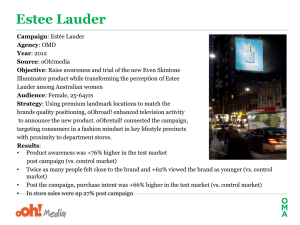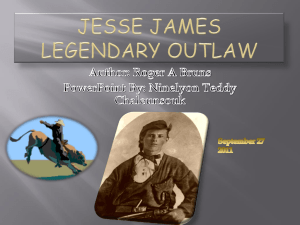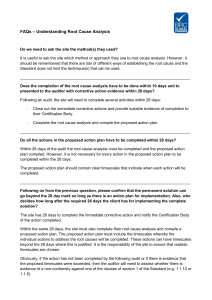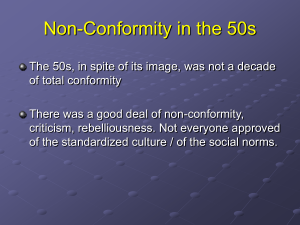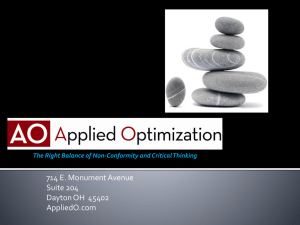Week 6 Positive & Negative Influences on Health
advertisement
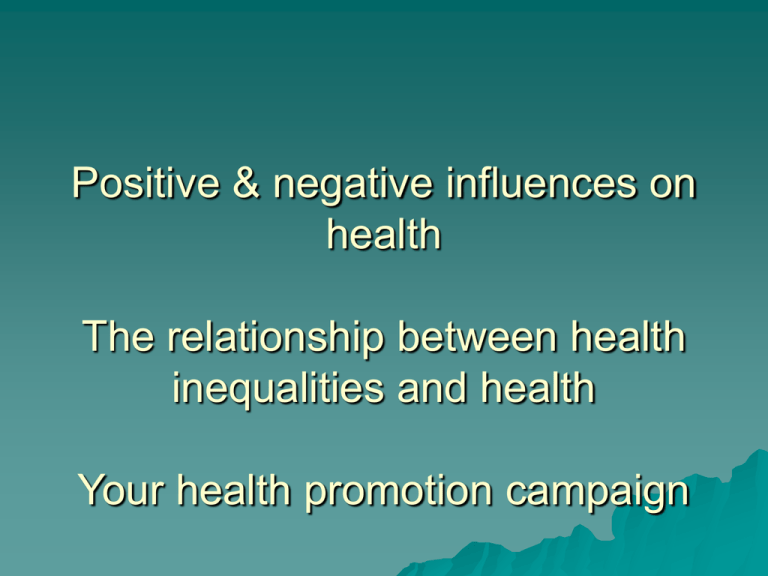
Positive & negative influences on health The relationship between health inequalities and health Your health promotion campaign Learning Outcomes Describe non-conformity to advice in your workplace Outline the requirements of assessments 1 & 2 with regards to educational models Identify positive & negative influences on health behaviours and health Describe the relationship between health inequalities and health Identify target population & their health needs Non-Conformity To Advice Why do people ‘ignore’ health promotion advice? What are the reasons for non-conformity in your own workplace? (For assessment 1 you will debate nonconformity for your own workplace because there are not enough words in the essay to debate all reasons for nonconformity) Non-Conformity to Advice In what circumstances might the following reasons for non-conformity happen: Not understanding advice Use of jargon by health professional Forgetting Learning disability Don’t agree with advice CBA Physical or psychological addiction Ingrained lifestyle patterns Culture Peer pressure Denial of condition Financial reasons (There are many more!) Health Promotion Models & Your Health Promotion Campaign Assessment 1 and Assessment 2 need to include DIFFERENT models of health promotion Assessment 1: compare and contrast 2 models of health promotion that could be used to reach your target audience – ensure these are NOT the models you will be using in your campaign Assessment 2: Choose 2 models of health promotion that you will use to do your own health promotion campaign. You will need to explain why you chose these models during your presentation and in your report. Example. Assessment 1: Identify your target population and their health needs. Investigate 2 models of health that would meet these needs Target group: Consultants. Health Needs: Hand Washing. Social Change model – government introduce legislation to target all health professionals’ hand washing. Managers introduce accountability in the hospital to train, monitor and enforce. Behaviour Change model – leaflets distributed to all consultants putting the emphasis on the problems that can be caused to them & others if hand washing is not adhered to. These two models would be described, compared and contrasted to highlight the advantages and disadvantages of using these models for this purpose. Example. Assessment 2: Rationalise the models of health and health promotion you are using to deliver your campaign Target Group: Consultants. Health Needs: Hand washing. Education model – provide posters detailing when to wash hands and why. Empowerment model – provide easily accessible hand washing facilities with posters with info on when to hand wash. Describe the models and justify why you used them for this particular health promotion campaign. You will outline and justify their use in the presentation and also in the report. Positive & Negative Influences on Health Debate & Discuss: The more you know about someone or a group of people the better you can create a health promotion campaign. What How do you need to know? will you find out this information? Positive & Negative Influences on Health: Gender http://www.youtube.com/watch?v=TPahu 5oJj4A http://www.youtube.com/watch?v=rC0oA Ww6eRs http://www.youtube.com/watch?v=i_wHZ dD50t0&NR=1 Positive & Negative Influences on Health: Gender Women live on average 6 years longer than men but record higher levels of morbidity in both chronic and acute illnesses 51% of population and account for 60-65% of NHS expenditure Over 60% of GP consultations are women Over 60% of hospital beds occupied by women Admissions to psychiatric hospitals are 3 times higher for women than men for some disorders. WHY? (Source: DoH 1996, Miles 1991) Research & Discuss other Positive & Negative Influences on Health Income Housing Employment Social Class Ethnicity Culture Race Social cohesion & exclusion Laws Health Inequalities Explanations for health inequalities: Artefact - Statistics are man made & not a reflection of reality Social Selection - health determines social class & not vice versa Cultural/Behavioural - emphasis on the individual’s lifestyle, those from social classes I and II have higher unhealthy behaviours Materialist/Structural - ill health experiences by lower social classes who fewest resources, have hazardous jobs, live in poor housing, have poor education etc.



